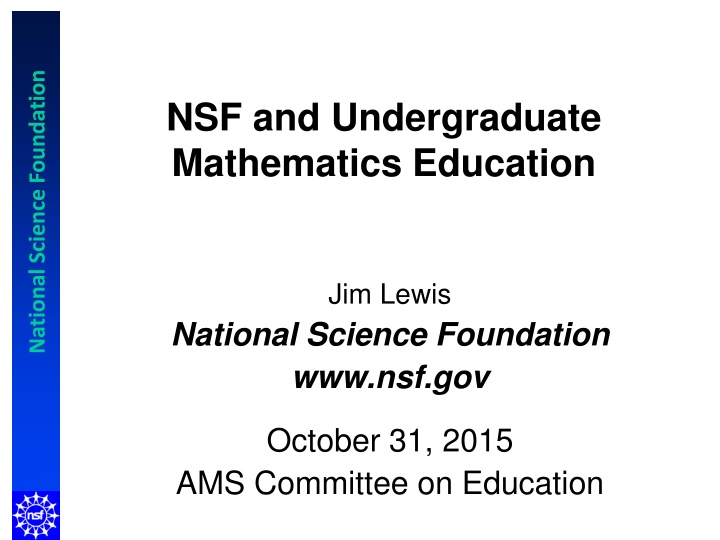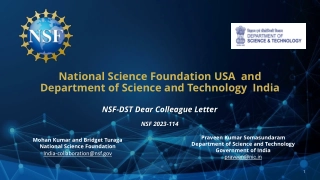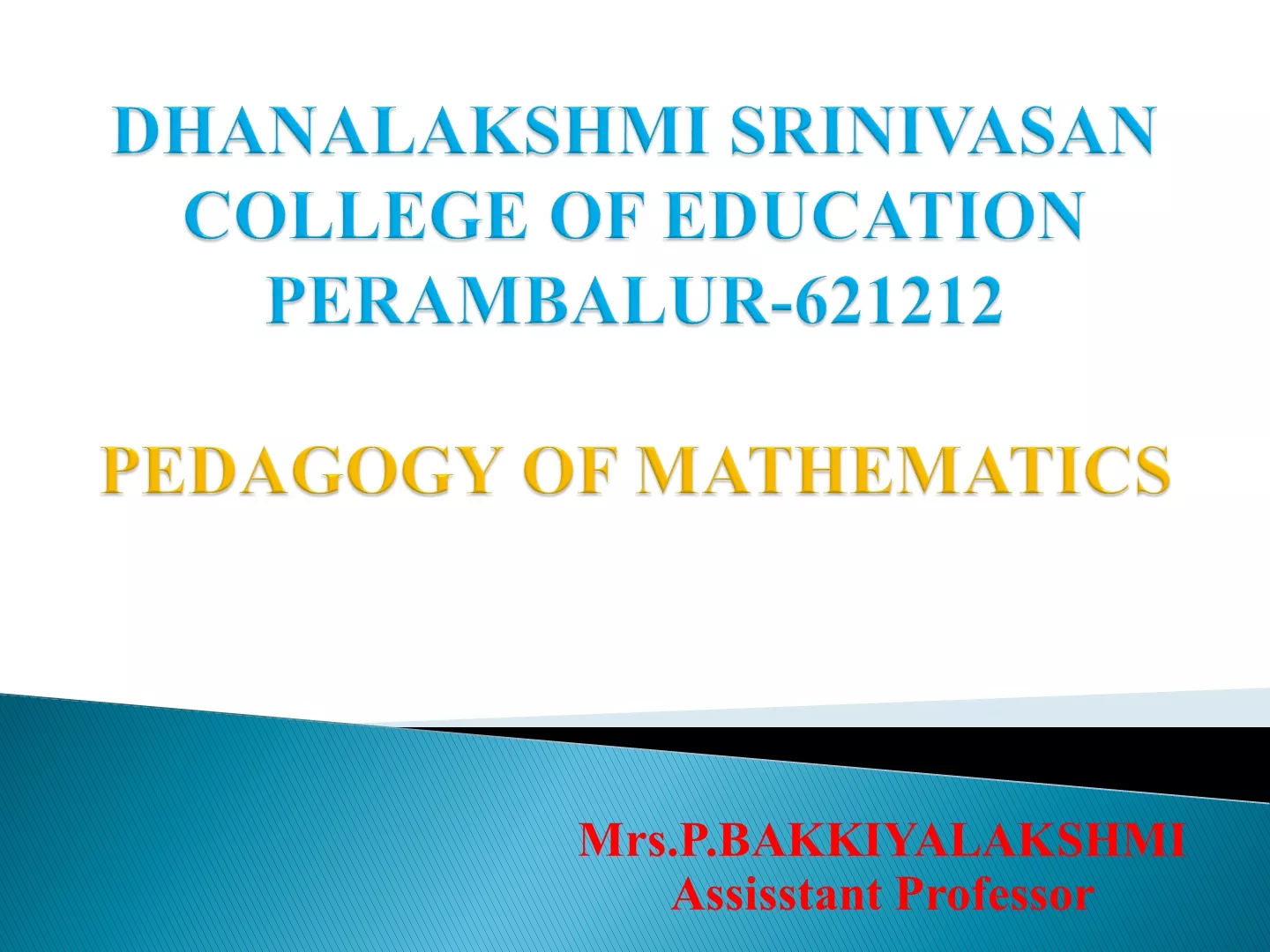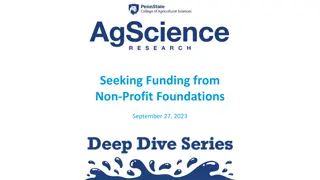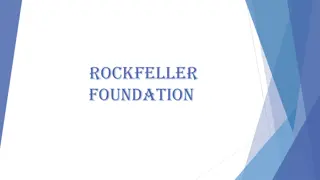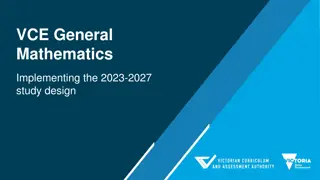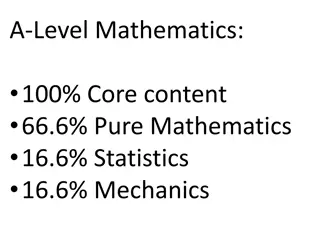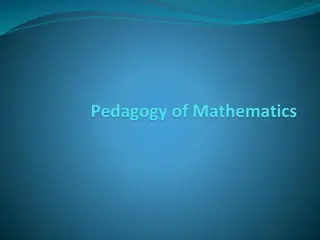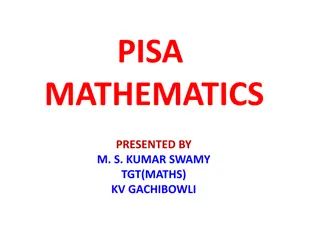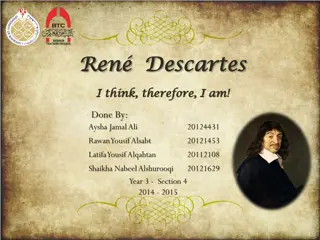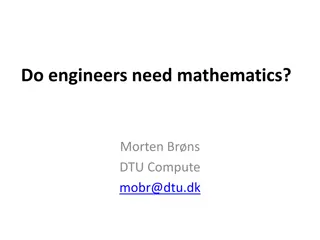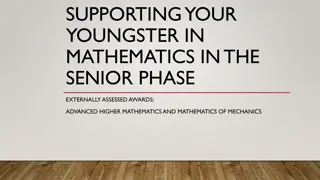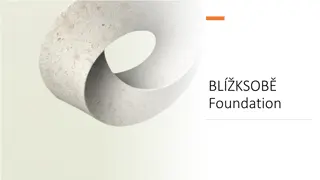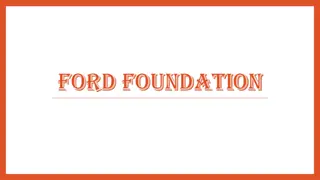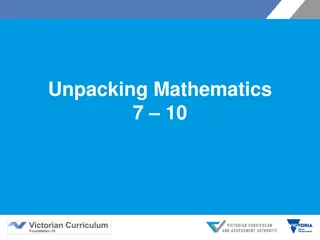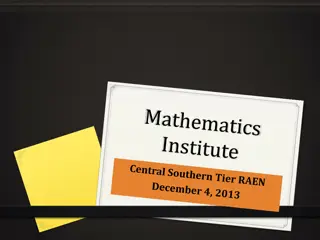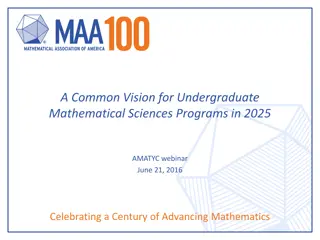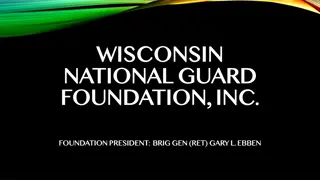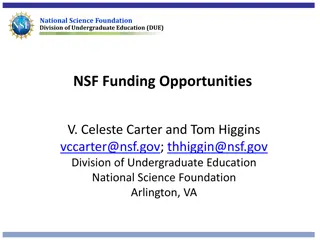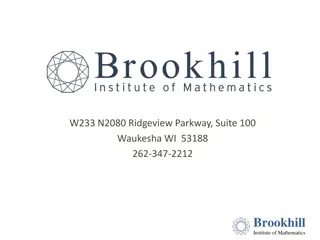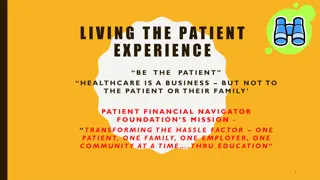National Science Foundation's Role in Improving Mathematics Education
National Science Foundation (NSF) plays a crucial role in enhancing mathematics education at all levels, from undergraduate to graduate. Through various initiatives and strategic plans, NSF aims to promote excellence in mathematics instruction, leverage technology for teaching improvement, and enhance leadership in educational settings.
Download Presentation

Please find below an Image/Link to download the presentation.
The content on the website is provided AS IS for your information and personal use only. It may not be sold, licensed, or shared on other websites without obtaining consent from the author.If you encounter any issues during the download, it is possible that the publisher has removed the file from their server.
You are allowed to download the files provided on this website for personal or commercial use, subject to the condition that they are used lawfully. All files are the property of their respective owners.
The content on the website is provided AS IS for your information and personal use only. It may not be sold, licensed, or shared on other websites without obtaining consent from the author.
E N D
Presentation Transcript
National Science Foundation NSF and Undergraduate Mathematics Education Jim Lewis National Science Foundation www.nsf.gov October 31, 2015 AMS Committee on Education
National Science Foundation The call to improve mathematics instruction in our colleges and universities is not new.
Towards Excellence - 1999 National Science Foundation Towards Excellence: Leading a Mathematics Department in the 21st Century, was written by the AMS Task Force on Excellence. The opening line was: We have a simple message: To ensure their institution s commitment to excellence in mathematics research, doctoral departments must pursue excellence in their instructional programs. Supported by NSF (RED-9550471) and EXXON Education Foundation
Applying the Science of Learning to the University and Beyond National Science Foundation It would be difficult to design an educational model that is more at odds with the findings of current research about human cognition than the one being used today at most colleges and universities. Change, July/August 2003
AMS Task Force on First-Year Mathematics Recommendations: First things first. Leadership matters success in this area depends upon the value assigned to it by a department s leadership; Harness the power of technology to improve teaching and learning; Invest in teaching graduate students to be good teachers. AMS Notices, June/July 2009 National Science Foundation
Context National Science Foundation Today there is Intense National and Federal interest in improving STEM Education Engage to Excel Co-STEM 5-year strategic plan Importance of first two years of STEM education in particular, success in mathematics is key Upper division mathematics is also important The Mathematical Sciences in 2025 The mathematics community is paying attention TPSE, AMS, MAA, SIAM
Federal Science, Technology, Engineering, and Mathematics (STEM) Education 5-Year Strategic Plan National Science Foundation Priority Areas/Interagency Working Groups P-12 STEM education Undergraduate education Graduate education Broadening participation Public engagement
Strategic objectives for Federal investment in undergraduate education National Science Foundation Implementation of evidence-based instructional practices and innovations Improve STEM education at 2-year colleges and transfer to 4-year colleges Support the development of university- industry partnerships to provide relevant and authentic experiences Address high failure rates in introductory undergraduate mathematics
Now is the time to focus on mathematics at the undergraduate and graduate level National Science Foundation Mathematics is essential in the preparation of the STEM workforce The nature and practice of science is becoming computationally intensive and data- driven across most fields New technologies and new understandings about learning and teaching allow new possibilities for instruction. If mathematics departments don t own the problem, someone else will.
Goals of the Directorate for Education and Human Resources (EHR) National Science Foundation Prepare the next generation of STEM professionals and attract/retain more Americans to STEM careers Develop a robust research community that can conduct rigorous research and evaluation to support excellence in STEM education Increase the technological, scientific and quantitative literacy of all Americans Broaden participation and close achievement gaps in all STEM fields.
EHR Thematic Framework National Science Foundation Learning and Learning Environments Develop understanding of the foundations of STEM learning; emerging contexts and tools; building new environments for learning in a technological society Broadening Participation in STEM Increase the scientific workforce by engaging and building capacity in all people in STEM learning and professional training STEM Professional Workforce Development Improve the education and preparation of a STEM professional workforce 11
EHR mathematics funding National Science Foundation Mathematics funding in EHR overall (FY2014) 11% of proposals contained a focus on mathematics 7.5% of proposals were focused exclusively on mathematics 2014 Improving Undergraduate STEM Education (IUSE) competition: ~6%
Directorate for Education and Human Resources National Science Foundation EHR has a budget of $866 M Division of Graduate Education Division of Research on Learning Division of Undergraduate Education 227M Division of Human Resource Development 273M 222M 144M EHR is not mentioned in The Mathematical Sciences in 2025
We see key areas of opportunity National Science Foundation Transition from HS to undergraduate education Implementation of active learning instruction Engagement of students from groups traditionally underrepresented in STEM Learning supported by technology New curriculum, data science, and computational approaches Partnerships across disciplines
Potential of Active Learning Strategies National Science Foundation PCAST: Classroom approaches that engage students in active learning improve retention of information and critical thinking skills, compared with a sole reliance on lecturing, and increase persistence of students in STEM majors. Freeman et al. (2014). Active learning increases student performance in science, engineering, and mathematics. Proceedings of the National Academy of Sciences. Meta-analysis of 225 studies that reported data comparing student performance in STEM courses under traditional lecturing versus active learning.
Impact of Active Learning National Science Foundation
Outcomes of Active Learning (Freeman et. al, 2014) National Science Foundation Increases in examination performance would raise average grades by a half a letter. Failure rates under traditional lecturing are 55% higher than the rates observed under active learning.
A special opportunity for mathematics: National Science Foundation NSF 15-026 Dear Colleague Letter: Increasing College Opportunity Through Improved Mathematics Success in the First Two Years of College (Archived) Only received 41 proposals : EAGERs, Supplements, Workshops. Successful proposals range from research intensive universities to community colleges. Awards: $6,151,962 from several EHR sources Why weren t there more proposals?
Example Topics National Science Foundation Graduate Assistant (GA) preparation for teaching, mentoring, and advising undergraduates (while they are GAs and when they enter the workforce). Dual Enrollment (e.g., college algebra while in high school) Development of Pedagogy Guide for departments , faculty & GAs to use (in the sense of MAA s Curriculum Guide) Assessment: Develop, evaluate, implement: Quantitative Biology Concept Inventory (QBCI) assessment of mathematics and quantitative concept learning goals in the context real-world life Novel approaches to lower level mathematics: (e.g., use of animations, data examples, etc.)
Division of Undergraduate Education Core DUE programs Advanced Technological Education (ATE) Improving Undergraduate STEM Education (IUSE) Noyce Teacher Scholars Program (Noyce) Scholarships in STEM (S-STEM) http://www.nsf.gov/div/index.jsp?div=DUE National Science Foundation
IUSE: EHR Deadlines (FY 2016) National Science Foundation 11/03/2015 01/13/2016 Engaged Student Learning Exploration and Design Development & Implementation I & II Institutional and Community Transformation Exploration and Design Development & Implementation http://www.nsf.gov/publications/pub_summ.jsp?WT.z_pims_id=505082&ods_key=nsf15585
Our Reality National Science Foundation Distribution of available funds depends on proposal pressure
National Science Foundation Proposal Pressure FY14 ENGINEERING Design and Development Tier 22 Discipline/Emphasis Exploration Tier TEACHER PREP 7 PHYSICS & ASTRO BIOLOGICAL SCIENCES CHEMISTRY 30 37 57 55 53 26 COMPUTING 62 50 EARTH SCIENCES 22 30 152 109 INTER & MULTI- DISCIPLINARY MATHEMATICS 64 187 52 66 SOC. & BEHAV. SCI. 31 23
Attributes of successful proposals National Science Foundation Collaborations with education researchers, cognitive/learning scientists Interdisciplinary opportunities
Scholarships + National Science Foundation Noyce: pre-service teacher preparation audience S-STEM: scholarships and co-curricular support for students with academic talent, who demonstrate financial need
HRD Programs that include an undergraduate focus National Science Foundation LSAMP: To significantly increase the numbers of students (historically under-represented in STEM) who successfully complete high quality degree programs in STEM disciplines (focus primarily on undergraduate level) ADVANCE: To develop systemic approaches to increase the representation and advancement of women in Academic STEM Careers CREST: To strengthen the national research competitiveness of Minority-serving institutions HBCU-UP: To enhance the quality of undergraduate STEM education and research at Historically Black Colleges or Universities TCUP: To promote high quality STEM education, research, and outreach programs at Tribal Colleges, Alaska Native-serving, and Native Hawaiian-serving institutions
National Science Foundation Additional Programs of Interest EHR Core Research (ECR) Discovery Research K-12 (DRK12) Graduate Research Fellowships (GRFP) NRT (Innovations in Graduate Education) EAGER, RAPID CAREER
Early-concept Grants for Exploratory Research (EAGER) To support exploratory work in early stages on potentially transformative research ideas or approaches Two years, up to $300,000 (total) Must contact a Program Director National Science Foundation Grants for Rapid Response Research (RAPID) To support projects having a severe urgency Must contact a Program Director Facilitating Research at Primarily Undergraduate Institutions (NSF 14-579) Research in Undergraduate Institutions (RUI) Research Opportunity Awards (ROA)
CAREER National Science Foundation Faculty Early Career Development Program (CAREER) NSF 15-555 To prepare the next generation of scientist educators For untenured assistant professors seeking to integrate research and teaching in innovative ways
Example Projects National Science Foundation CAREER (1452889) M. Wawro(Virginia Tech) An Interdisciplinary Study of Learning: Student Understanding of Linear Algebra in Physics CAREER (1453822) J. Noll (Portland State University) Transforming College Students Statistical Thinking: Data, Technology & Modeling (1505246) D. Farmer (American Institute of Mathematics AIM) Open resources for the mathematics curriculum Multi-format, high quality, field tested materials
A Theme - Graduate Student (GA) Preparation (IUSE) (1450746) D. Maki-PI (Indiana) (10/14) A Planning Conference/Workshop On Preparing Mathematical Sciences Graduate Students For Careers Teaching, Advising, and Mentoring Undergraduates National Science Foundation
Graduate Student TA Preparation (1539602) M. Jacobson-PI, University of Colorado at Denver MATH:EAGER:Promoting Undergraduate Success in Early College Mathematics through Graduate Teacher Training (1432381) PI J. Bookman (Duke) MAA project. Improving the Preparation of Graduate Students to Teach Undergraduate Mathematics. Vision: To enhance the mathematics community's ability to provide high quality, teaching-related PD & resources for GAs. National Science Foundation
Bressoud, Rasmussen, Braddy et. al. National Science Foundation Characteristics of successful programs in college calculus (NSF#0910240) Progress through calculus (NSF#1430540)
Tips for Success National Science Foundation Start EARLY (at LEAST 6 months prior to deadline) Get acquainted with FastLane (www.fastlane.nsf.gov) READ the Program Solicitation Know the program s specific guidelines and follow them! Contact a program officer to discuss your idea May provide useful information and help you refine your idea May also prevent you from applying to the wrong program Attend program webinars Sign up for NSF Updates (https://service.govdelivery.com/accounts/USNSF/subscriber/new) Become an NSF reviewer (And then become an NSF rotator )
Coming Attractions National Science Foundation Special pre-session on funding opportunities and proposal writing at the AMS Department Chairs meeting at JMM Monday afternoon 01/04/2016
Thank you National Science Foundation Jim Lewis wjlewis@nsf.gov
